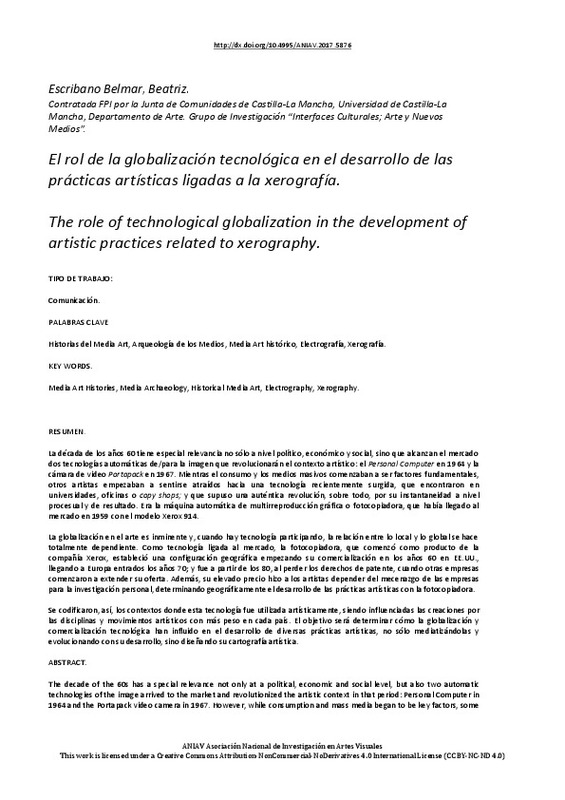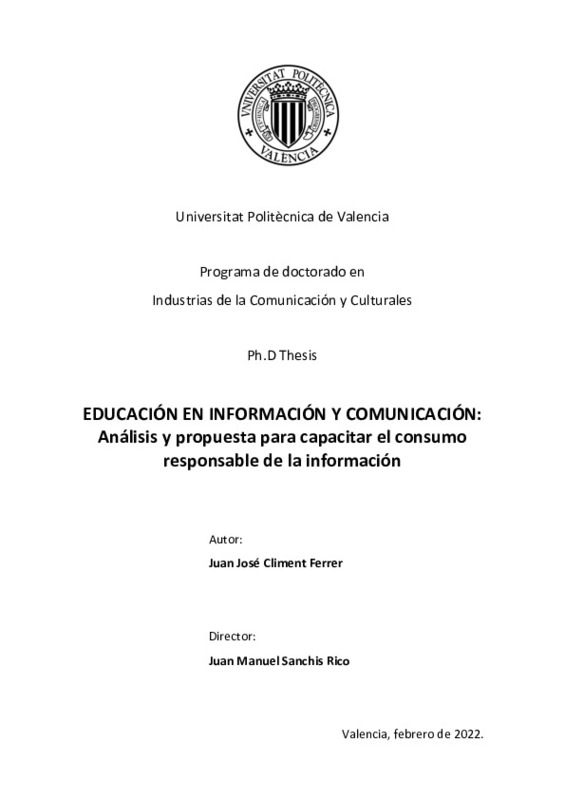|
Resumen:
|
[EN] The decade of the 60s has a special relevance not only at a political, economic and social level, but also two automatic technologies of the image arrived to the market and revolutionized the artistic context in that ...[+]
[EN] The decade of the 60s has a special relevance not only at a political, economic and social level, but also two automatic technologies of the image arrived to the market and revolutionized the artistic context in that period Personal Computer in 1964 and the Portapack video camera in 1967. However, while consumption and mass media began to be key factors, some other artists became attracted to a newly emerging technology, which were found in universities, offices or copy shops; and that supposed a real revolution by its instantaneity both at procedural and outcome level. It was the automatic machine of graphic multiireproduction or photocopier, that come on the market in 1959 with the Xerox 914 model.
Globalization in art is imminent and, whenever technology is involved the relationship between the local and the global becomes completely dependent. As technology linked to the market, the photocopier, which began as a Xerox company´s product, established a geographic configuration starting its commercialization in USA in the 60s, arriving in Europe in the 70s; and it was since the 1980s, when losing patent rights, that other companies began to extend their products. In addition, due to its high price artists relied on the patronage for personal research, determining the geographical development of artistic practices by the photocopier.
In this way, the contexts where this technology was artistically used were codified, being the creations influenced by disciplines and artistic movements with the greatest weight in each country. The objective will be to determine how globalization and technological marketing have influenced the development of diverse artistic practices, not only mediatizing and evolving with their improvement, but also designing their artistic cartography.
[-]
[ES] La década de los años 60 tiene especial relevancia no sólo a nivel político, económico y social, sino que alcanzan el mercado dos tecnologías automáticas de/para la imagen que revolucionarán el contexto artístico: el ...[+]
[ES] La década de los años 60 tiene especial relevancia no sólo a nivel político, económico y social, sino que alcanzan el mercado dos tecnologías automáticas de/para la imagen que revolucionarán el contexto artístico: el Personal Computer en 1964 y la cámara de video Portapack en 1967. Mientras el consumo y los medios masivos comenzaban a ser factores fundamentales, otros artistas empezaban a sentirse atraídos hacia una tecnología recientemente surgida, que encontraron en universidades, oficinas o copy shops; y que supuso una auténtica revolución, sobre todo, por su instantaneidad a nivel procesual y de resultado. Era la máquina automática de multirreproducción gráfica o fotocopiadora, que había llegado al mercado en 1959 con el modelo Xerox 914.La globalización en el arte es inminente y, cuando hay tecnología participando, la relación entre lo local y lo global se hace totalmente dependiente. Como tecnología ligada al mercado, la fotocopiadora, que comenzó como producto de la compañía Xerox, estableció una configuración geográfica empezando su comercialización en los años 60 en EE.UU., llegando a Europa durante los años 70; y fue a partir de los 80, al perder los derechos de patente, cuando otras empresas comenzaron a extender su oferta. Además, su elevado precio hizo a los artistas depender del mecenazgo de las empresas para la investigación personal, determinando geográficamente el desarrollo de las prácticas artísticas con la fotocopiadora.Se codificaron, así, los contextos donde esta tecnología fue utilizada artísticamente, siendo influenciadas las creaciones por las disciplinas y movimientos artísticos con más peso en cada país. El objetivo será determinar cómo la globalización y comercialización tecnológica han influido en el desarrollo de diversas prácticas artísticas, no sólo mediatizándolas y evolucionando con su desarrollo, sino diseñando su cartografía artística.
[-]
|










